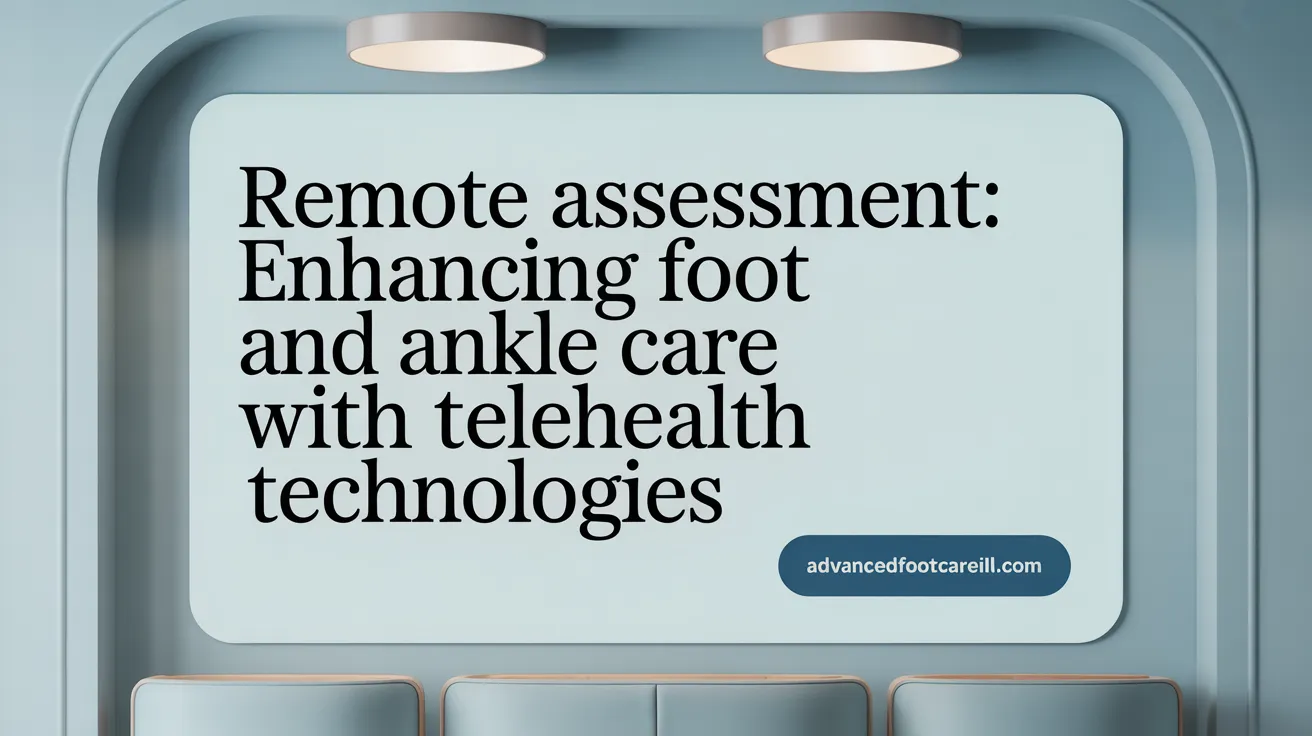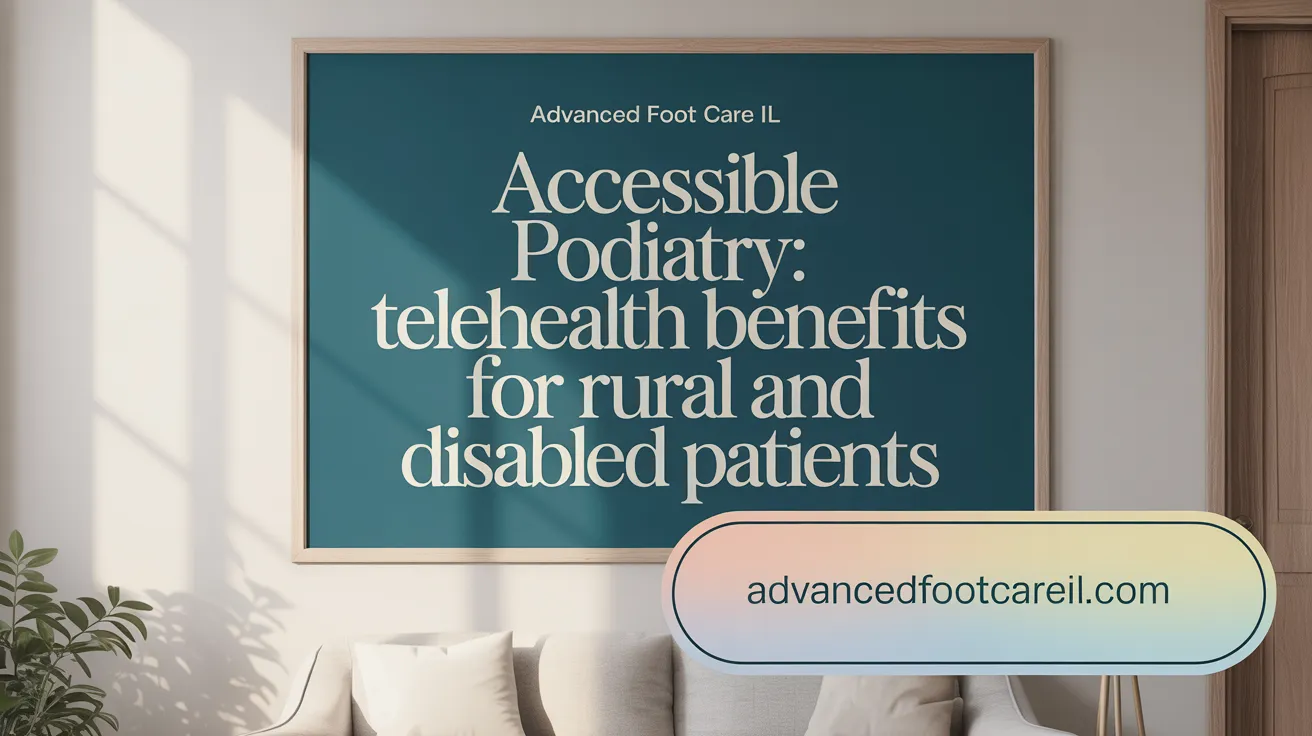Understanding Telehealth's Role in Modern Podiatry
Telehealth has transformed healthcare delivery across many specialties, and podiatry is no exception. Virtual consultations, remote monitoring, and digital tools now complement traditional foot and ankle care, offering new possibilities for patient access, convenience, and management of musculoskeletal and dermatological conditions. This article explores when and how telehealth helps in podiatry, assessing its applications, benefits, implementation strategies, efficacy, and best practice guidelines to optimize virtual foot care.
Common Telehealth Applications in Podiatry

What are the common telehealth applications used in podiatry?
Telehealth in podiatry encompasses a variety of digital tools and virtual practices aimed at improving patient care from afar. The most familiar application is virtual consultations via video platforms, allowing patients to discuss their foot and ankle issues directly with healthcare providers without leaving home. These face-to-face interactions, facilitated through high-definition video, enable visual assessment of conditions such as swelling, skin abnormalities, or deformities.
In addition to live consultations, digital diagnostic tools are increasingly integrated into podiatric care. Smartphone apps and specialized software can support remote assessment by capturing and analyzing images of the foot, which are useful for monitoring wounds, deformities, or signs of infection. These images can be processed using reliable analysis software like ImageJ, helping clinicians evaluate healing progress or detect early symptoms of complications.
Digital imaging extends further with tools such as digitized X-rays or scan uploads, enabling comprehensive evaluation without requiring in-person visits. Telemedicine apps also facilitate ongoing patient engagement, providing educational resources, reminders for self-care, and structured follow-up for chronic conditions like diabetic foot ulcers.
Emerging technologies are broadening the scope of remote foot and ankle health management. Dermal thermography, which measures skin temperature variations, and hyperspectral imaging, capable of detecting tissue oxygenation and perfusion, are advanced tools that assist in early diagnosis and disease monitoring. These innovations promise to enhance remote diagnostics, especially for high-risk or geographically isolated patients.
Overall, these telehealth applications improve access to specialist care, shorten waiting periods, and support effective remote management. However, it remains important for practitioners to develop standardized guidelines to ensure consistent quality and safety across different platforms and technologies.
When Virtual Consultations Are Most Beneficial in Podiatry
 Virtual consultations in podiatry are especially useful in managing conditions that require ongoing monitoring, patient education, and conservative treatments. They are highly suitable for patients dealing with chronic foot and ankle issues such as plantar fasciitis, flat foot, or diabetic foot ulcers, where physical examination can often be supplemented by visual assessment via high-definition video. For conditions that predominantly involve symptom discussion and visual inspection, telehealth provides an effective alternative to in-person visits.
Virtual consultations in podiatry are especially useful in managing conditions that require ongoing monitoring, patient education, and conservative treatments. They are highly suitable for patients dealing with chronic foot and ankle issues such as plantar fasciitis, flat foot, or diabetic foot ulcers, where physical examination can often be supplemented by visual assessment via high-definition video. For conditions that predominantly involve symptom discussion and visual inspection, telehealth provides an effective alternative to in-person visits.
These remote consultations are particularly advantageous for patients facing challenges like limited mobility, geographic barriers, or busy schedules. For individuals living in rural or underserved areas, virtual visits offer immediate access to specialists without the need for long-distance travel. Patients who find leaving their homes difficult or risky, such as those with disabilities or high risk of infection, benefit greatly from receiving expert care safely from their own homes.
Furthermore, virtual podiatry appointments excel in follow-up care and patient education. Clinicians can review diagnostic images, share screen results, and discuss treatment progress conveniently. This approach helps in managing chronic conditions effectively, ensuring continuity of care, and providing timely advice on symptom management. It also reduces waiting times, travel expenses, and time away from work, aligning with modern healthcare goals of accessibility, efficiency, and patient satisfaction.
While not suitable for all kinds of procedures, telehealth in podiatry is most beneficial when physical examination is limited to visual inspection and conversation rather than hands-on treatment. This strategic use of technology enhances patient outcomes, minimizes delays in care, and supports safe, cost-effective management of foot and ankle issues.
Benefits and Effectiveness of Telehealth in Foot and Musculoskeletal Care

What are the benefits and advantages of telehealth in foot and musculoskeletal care?
Telehealth has transformed foot and musculoskeletal healthcare by improving access and reducing wait times. Patients in rural or underserved areas can now receive specialist consultations without traveling long distances. This convenience is especially important during health crises like the COVID-19 pandemic, which prompted a rapid shift to virtual services.
Patients report high satisfaction with telehealth services, citing ease of use and the ability to consult from the comfort of their homes. The process involves scheduling online, receiving digital forms, and joining virtual visits via links, making it straightforward.
Clinical evidence supports that telehealth can produce outcomes comparable to traditional in-person care. Studies have shown significant improvements in symptoms like foot pain and plantar fasciitis, with many patients discharged to self-management after virtual care.
Cost savings are another major benefit. A financial analysis across a year estimated approximate net savings of about £8,520 ($10,233). These savings come from reduced travel expenses, fewer missed workdays, and lower healthcare delivery costs. Moreover, virtual consultations increase efficiency by allowing quicker access and more flexible scheduling.
Safety is paramount, and no serious incidents or adverse outcomes have been reported in virtual podiatric services. During the pandemic, these services also minimized COVID-19 exposure risk, underscoring their role in maintaining safe and continuous care.
In summary, telehealth offers a convenient, cost-effective, and safe alternative to in-person visits, enhancing patient outcomes while reducing barriers to essential foot and musculoskeletal care.
How effective are virtual consultations in managing foot health compared to traditional in-person visits?
Research evaluating virtual musculoskeletal podiatry services involving 492 patients found significant benefits. Patients experienced notable pain reduction, measured through the visual analogue scale (VAS), whether or not orthoses were prescribed. Many were able to manage their symptoms independently after discharge, indicating successful management.
Systematic reviews across multiple studies confirm that telehealth can deliver outcomes similar to face-to-face treatment for many conditions, including foot pain, plantar fasciitis, and flat foot. The convenience reduces wait times and travel costs, making care more accessible and improving adherence.
While some conditions requiring physical examinations or direct interventions still need in-person care, telehealth effectively handles follow-ups, symptom monitoring, and visual assessments, such as inspecting wounds or deformities via video. Sharing diagnostic images and conducting virtual assessments have been shown to support accurate diagnoses.
Overall, virtual consultations serve as a valuable tool in managing foot health, especially suited for chronic conditions and follow-up appointments, without compromising care quality.
Implementing Telemedicine in Podiatric Practice: Workflow and Integration
How is telemedicine implemented and integrated into podiatric clinical workflows?
Integrating telehealth into podiatric practices begins with selecting secure, compliant digital platforms that facilitate real-time video and phone consultations. These platforms must adhere to privacy standards such as HIPAA to protect patient confidentiality.
Staff training is a vital component. Podiatrists, nurses, and administrative personnel should be educated on using technology efficiently, following clinical protocols, and managing documentation and billing processes. Clear procedures for virtual assessments and follow-up care help ensure consistency and quality.
Seamless integration with electronic health records (EHR) systems is critical. This allows clinicians to document virtual visits accurately, share diagnostic information, and coordinate ongoing care effectively. Accurate record-keeping enhances patient safety and continuity of care.
Preparation for patients improves the overall experience and effectiveness of virtual visits. Patients should receive detailed instructions on how to connect, information about consent procedures, and guidance on sharing images or describing symptoms clearly. Technical support can reduce disruptions during consultations.
Hybrid care models are gaining popularity, combining virtual and in-person visits. This approach is particularly useful when physical interventions are necessary but can be complemented with remote follow-ups for ongoing monitoring and patient education.
To maintain high standards, implementing standardized telehealth protocols tailored to podiatry is essential. These guidelines should cover wound management, visual assessment techniques, and quality assurance measures. Overall, thoughtful planning and integration optimize the benefits of telemedicine, extending care reach and efficiency in podiatric services.
Best Practices and Guidelines for Telehealth in Podiatric Medicine
What are best practices and guidelines for using telehealth in podiatric medicine?
Implementing telehealth in podiatry requires careful attention to several important practices. Firstly, maintaining patient privacy and data security is paramount. Clinicians must comply with regulations like HIPAA, ensuring secure communication channels and verifying patient identity before consultations.
Establishing a strong practitioner-patient relationship is essential. During the virtual visit, practitioners should obtain informed consent explicitly for telehealth services, clarifying the scope and limitations of virtual care. Accurate documentation of the consultation, including patient details, assessments, and recommendations, should be maintained diligently.
Patient selection is a critical factor. Telehealth is well-suited for managing conditions such as foot pain, plantar fasciitis, and flat foot but may be inappropriate for cases requiring hands-on examination or procedures like injections and surgery.
For effective visual assessment, patients should be prepared with proper attire, good lighting, and a stable camera setup. Standardized templates and checklists can help in collecting consistent visual information, such as photo-sharing of symptoms like swelling or skin lesions.
Staying informed about legal frameworks, reimbursement policies, and malpractice considerations is necessary to mitigate risks. Clinicians should be familiar with their jurisdictional requirements and billing procedures for virtual care.
Moreover, engaging with professional communities, such as CPMA, and pursuing continuing education enhance clinicians’ ability to adopt best practices. These efforts help navigate the evolving landscape of telehealth and ensure high-quality patient care despite the current lack of comprehensive, evidence-based guidelines.
The Future of Telehealth in Podiatry
Telehealth represents a pivotal advancement in podiatric medicine, offering greater accessibility, safety, and patient-centered care. Its success during the COVID-19 pandemic demonstrated that many foot and musculoskeletal conditions can be effectively managed remotely without compromising quality. As technology evolves and telehealth platforms become more integrated into clinical workflows, clinicians will be better equipped to deliver hybrid models of care that combine the best of virtual and in-person services. Adopting established best practices and staying abreast of emerging evidence and guidelines will ensure telehealth's continued role as a vital tool in podiatry, improving outcomes for diverse patient populations worldwide.
References
- An evaluation of a virtual musculoskeletal podiatry service ...
- Patient Outcomes of Virtual Foot and Ankle Telephone ...
- Podiatry Telehealth: What is it and how it works?
- Telehealth: The Advantages of Telemedicine
- Addressing Podiatrists' Concerns with Telehealth - CPMA
- Benefits of Telehealth Podiatry Appointments
- Does Telemedicine Really Work for Podiatry?
- The Importance of Telehealth in Podiatry
- A scoping review of foot and ankle telemedicine guidelines
